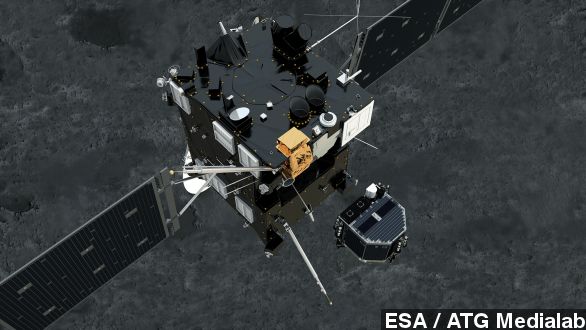Ten years, four billion miles, and several complicated maneuvers later, the Rosetta probe is readying itself to enter orbit around Comet 67P/Churyumov-Gerasimenko (that's Chury, for short) and make history.
After much planning during the 1990s, the European Space Agency, or ESA, launched Rosetta in 2004 from French Guiana to the tune of 1.3 billion euros with the expressed purpose of eventually meeting the 2-mile-wide Chury in deep space. (Via DLR / CC BY 3.0)
In order to do that, the probe had to undergo a winding series of maneuvers to reach the comet including using Earth as a space slingshot not once, but three times, and going into a deep space hibernation for two and a half years. (Via DLR)
It woke up from that hibernation in January of this year and has been steadily approaching Chury ever since. (Via Space.com)
Now that it's finally within orbitting distance of Chury, Rosetta will match its speed, perform several triangular orbits as it approaches, and deploy a fridge-sized lander called "Philae" in November once it gets close enough. (Via European Space Agency)
So beyond the fact that both orbiting and landing on a comet will be historical firsts for mankind, what's the point of Rosetta's mission? Simple, to learn more about where we came from.
"The biggest question that we're trying to get an answer to is where did life on earth come from. It's like, did it start, how did life get going, was it the building blocks of life that were brought to us from comets." (Via BBC)
Discover Magazine notes that seeing as how comets have been around since before planets themselves even existed, "They consist of material that’s believed to be relatively pristine. ... Scientists hope to gain valuable insights into the origin and evolution of the solar system, including our own planet."
The odd shape of the comet, which some have compared to a rubber duck, may pose a problem for landing, though. The Guardian spoke to a member of the research team who seemed a little concerned.
“The scientists are saying, 'Which bit do we want to land on?,' and the engineers are saying, 'Blimey, how will its shape affect the gravitational field?' At the end of the day we just want a safe landing. We’ve been waiting a long time for this.”
But, as a writer over at The Planetary Society notes, ESA plans to select five candidate landing sites by the end of the month and a final site by mid-September. So they still have plenty of time to figure out how they want to touch down.
ESA will be live streaming Rosetta's final approach starting Wednesday morning.


